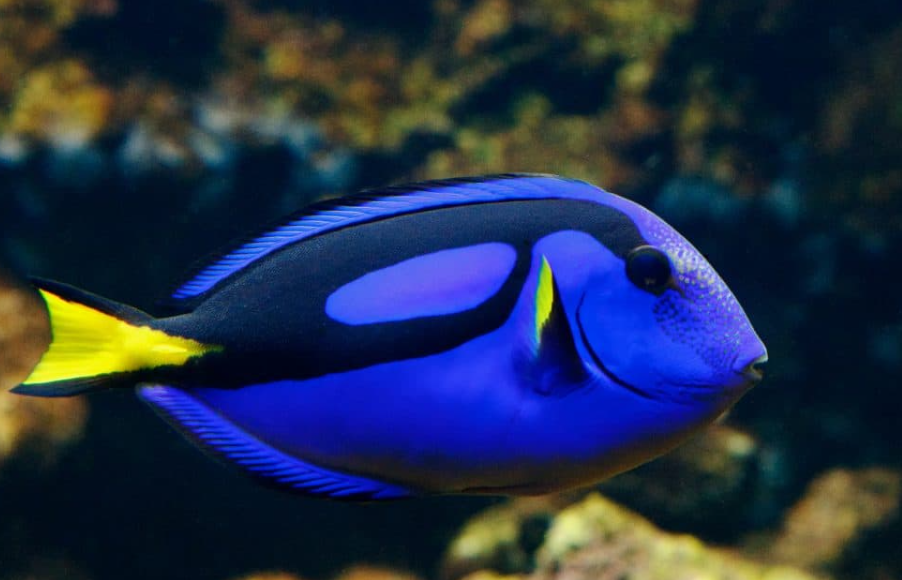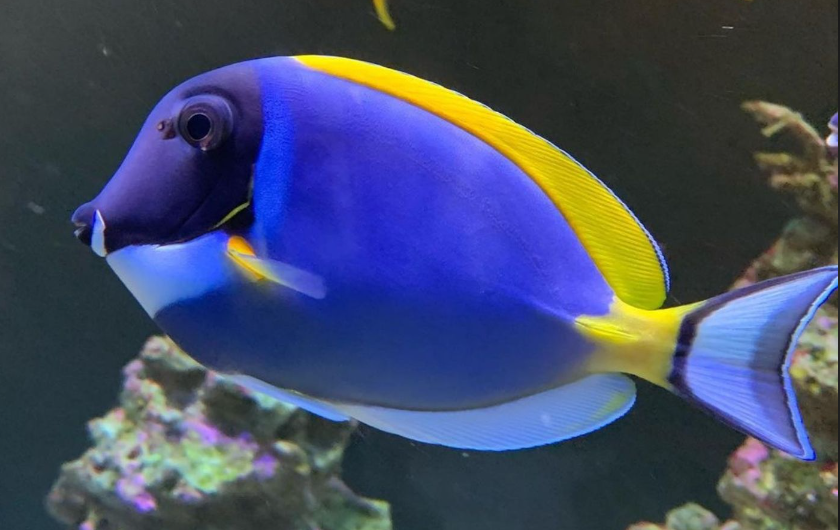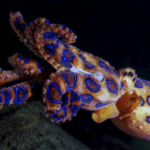Quick Top 10 Facts about Blue Tang Fish
| SCIENTIFIC NAME | Paracanthurus hepatus (Blue Tang) |
| CLASSIFICATION |
KINGDOM: Animalia PHYLUM: Chordata CLASS: Actinopterygii ORDER: Perciformes FAMILY: Acanthuridae GENUS: Paracanthurus |
| SIZE | Typically up to 12 inches (30 cm) in length |
| HABITAT | Coral reefs in the Indo-Pacific Ocean |
| DIET | Primarily herbivorous, feeding on algae and small marine plants |
| SPECIES | One main species, the Blue Tang (Paracanthurus hepatus), also known as the Palette Surgeonfish |
| COUNTRY | Found in the Indo-Pacific region, from East Africa to the Pacific Islands |
| GESTATION PERIOD | Eggs are externally fertilized, and incubation lasts a few days before hatching |
| LIFE SPAN | Typically 8 to 10 years in the wild |
| CONSERVATION STATUS | Not currently endangered, but overfishing for the aquarium trade and habitat destruction are concerns |
Amazing Facts About Blue Tang Fish
1. Famous for their vibrant blue color
Blue Tangs are famous for their striking electric blue color, with yellow accents, which makes them a popular species in aquariums.
2. Also known as the Palette Surgeonfish
The Blue Tang is sometimes referred to as the “Palette Surgeonfish” because of its beautiful color pattern and sharp spines (called “scalpel”) located near its tail.
3. Herbivorous diet
Blue Tangs are primarily herbivores and graze on algae and other plant matter, playing an essential role in controlling algae growth on coral reefs.
4. Symbiotic relationships
These fish have mutualistic relationships with certain types of coral, helping to keep coral reefs healthy by preventing algae overgrowth.
5. They can produce sharp spines
The sharp spines on their tail are used as a defense mechanism against predators, which can cause injury if the fish feels threatened.
6. Famous in pop culture
Blue Tang Fish are well-known to the general public due to their prominent role as the character “Dory” in the animated films *Finding Nemo* and *Finding Dory*.
7. Active swimmers
Blue Tangs are agile swimmers and can cover long distances in the ocean, often found around reefs where they forage for food.
8. Juveniles are yellow
The juveniles of Blue Tang Fish are bright yellow in color, and they gradually turn blue as they mature.
9. Can adapt to aquarium life
Blue Tang Fish are commonly kept in marine aquariums, though they require large tanks with proper filtration to replicate their natural reef environment.
10. Threatened by coral reef destruction
Although Blue Tang Fish are not endangered, their population is at risk due to the destruction of coral reefs, which provide their primary habitat, and overfishing for the aquarium trade.
Scientific name, Acanthurus coeruleus, and its distinctive physical features
The blue tang, or Paracanthurus hepatus, is a fascinating species of marine fish that is a member of the Acanthuridae family. It is often found along the shores of the Indo-Pacific region, the Great Barrier Reef, and East Africa. This vibrant fish is a favourite among aquarium enthusiasts because of its striking blue body and fins.
Blue Tang Fish as a popular and fascinating species
The Blue Tang has a unique body shape characterised by a pointed nose and an oval form that is laterally compressed. Given that its greatest length is 12 inches, it is regarded as a medium-sized fish in the marine environment. The scalpel, or sharp, retractable spine, that is located near the Blue Tang’s tail makes it easy to identify the animal. Although the spine shields the body from potential predators, handling it roughly might result in serious harm.
Feeding habits of Blue Tang Fish, which primarily consist of herbivorous diet
Blue tangs are herbivores since algae and other plant materials are their main source of diet. They do a crucial job of keeping the reefs from becoming overgrown and suffocating the corals because they feed on algae. These fish are well known for their superb swimming abilities, which allow them to navigate across coral reefs with ease. Despite their vivid appearance, blue tangs may coexist peacefully with many other fish species in a well-maintained aquarium.
Primarily found in the tropical waters of the Atlantic Ocean and the Caribbean Sea
The Blue Tang, sometimes called Paracanthurus hepatus, is a kind of surgeonfish that is well-known for its striking blue hue and distinctive form. This fish, which may be found in the warm coastal waters of the Indo-Pacific area, has drawn the interest of both marine aficionados and viewers of the well-known animated movie Finding Nemo.

Fascinating facts about Blue Tang Fish
Physical characteristics of Blue Tang Fish, such as their vibrant blue coloration
The oval-shaped body and vivid blue colouring of the Blue Tang define it. It features a golden tail and a unique black spine that resembles a scalpel close to the tail fin. The purpose of this spine is defensive and predatory protection. Young blue tangs are distinguished by their vivid yellow hue and blue patterns.
Size and length of Blue Tang Fish
Blue tangs are medium-sized fish in the ocean, with a maximum length of 12 inches (30 cm). On the other hand, some people have been known to grow as large as 15 inches (38 cm).
natural habitat of Blue Tang Fish includes coral reefs and rocky coastlines
Lagoons, rocky shorelines, and coral reefs are typical locations for blue tangs. Their preferred temperature range for warm tropical seas is between 75 and 82 degrees Fahrenheit (24 and 28 degrees Celsius). These fish are renowned for being superb swimmers and for being able to travel great distances in pursuit of food and favourable environments.
Diet of Blue Tang Fish: algae and other marine plants
As herbivores, blue tangs mostly consume algae. They remove algae from rocks and coral by scraping it with their tiny, pointed teeth. In addition to being necessary for their survival, this diet keeps algae from growing out of control, which benefits coral reef health.
Reproductive behaviour of Blue Tang Fish
It is known that blue tangs are oviparous, which means that they procreate by depositing eggs. Males and females congregate in groups and participate in wooing activities throughout the breeding season. The male externally fertilises the eggs after the female releases them into the water. After the eggs hatch, the larvae land on the reef, where they mature into adult fish.
Social behaviour of Blue Tang Fish, which often form small groups
Blue Tangs usually live in couples or small groups. Their social organisation is hierarchical, with a dominant male at the top. These fish use a variety of body language and colour shifts to communicate with one another, which aids in the establishment and maintenance of their social structure.

Conservation status of Blue Tang Fish, highlighting any threats they face
In the wild, blue tangs are threatened in a number of ways, despite their popularity. Population declines in certain locations have been attributed to overfishing, habitat loss, and the aquarium trade. Currently classified as a “Least Concern” species by the International Union for Conservation of Nature (IUCN), conservation efforts must be maintained if the Blue Tang is to survive into the future.
Place in Pop Culture and role in movie
The Blue Tang became well-known and well-liked after the 2003 release of the animated movie Finding Nemo. The Blue Tang character “Dory,” portrayed by Ellen DeGeneres, gained popularity among viewers of all ages. The demand for Blue Tangs in the aquarium trade has surged as a result of the species’ greater awareness, underscoring the need for sustainable methods and ethical pet care.
importance of understanding and conserving Blue Tang Fish
The Blue Tang is an intriguing fish due to its vivid blue hue, distinct form, and intriguing habits. Even though aquarium aficionados often choose them, it is imperative that their protection in the wild be given first priority. We can help to safeguard these amazing animals and maintain their natural habitats by learning about and respecting them.
FAQ (Frequently Asked Questions) about Blue Tang Fish
Q: What is a Blue Tang Fish?
Ans: The Blue Tang, also known as the Palette Surgeonfish or Paracanthurus hepatus, is a vibrant blue fish found in tropical and subtropical waters of the Indo-Pacific Ocean. It is famous for its striking blue color and yellow tail, which resemble a palette, hence the name. Blue Tangs are herbivores and are often found in coral reefs, where they graze on algae.
Q: Where do Blue Tang Fish live?
Ans: Blue Tangs are native to the Indo-Pacific Ocean, primarily found around coral reefs in regions such as the Great Barrier Reef, Hawaii, and the Philippines. They live in warm waters at depths ranging from shallow to deeper coral-rich areas, where they can graze on algae growing on rocks and corals.
Q: What do Blue Tang Fish eat?
Ans: Blue Tangs are herbivores and feed primarily on algae. They use their specialized teeth to scrape algae from rocks and corals in their environment. In the aquarium, they thrive on a diet of marine algae, seaweed, and occasionally high-quality fish pellets or frozen foods designed for herbivorous fish.
Q: Are Blue Tang Fish good aquarium fish?
Ans: Yes, Blue Tangs can be kept in aquariums, but they require a well-maintained tank with plenty of space, ideally over 75 gallons. They need live rock, proper filtration, and good water quality to thrive. These fish are relatively easy to care for as long as their specific needs are met, including a balanced herbivorous diet and regular water changes.
Q: How big do Blue Tang Fish get?
Ans: Blue Tangs typically grow to around 12 inches (30 cm) in length. They have an oval body shape and are known for their vibrant blue coloration, with a distinctive yellow tail that serves as a “scalpel” for defense when threatened.
Q: What is the lifespan of a Blue Tang Fish?
Ans: Blue Tangs can live for 8 to 10 years in the wild, and with proper care, they can live up to 20 years in captivity. A healthy diet, stable water conditions, and sufficient space are essential for ensuring a long lifespan for a Blue Tang.
Q: Do Blue Tang Fish have predators?
Ans: Yes, Blue Tangs have natural predators in the wild, including larger fish such as groupers, snappers, and predatory reef sharks. However, their vibrant blue color and sharp yellow tail, which they can use as a defense weapon, help deter many potential threats. They often swim in schools to reduce the risk of predation.
Q: How do Blue Tang Fish reproduce?
Ans: Blue Tangs reproduce through external fertilization. During the spawning season, males and females release eggs and sperm into the water column in a synchronized manner. The eggs float to the surface and hatch into larvae, which eventually settle in the reef environment and undergo metamorphosis into juvenile fish.
Q: Are Blue Tang Fish endangered?
Ans: Blue Tangs are not currently considered endangered, but they are under threat due to overfishing and the aquarium trade. Their population is also impacted by the degradation of coral reefs, which are their natural habitat. Conservation efforts are needed to protect coral ecosystems and ensure the long-term survival of Blue Tang fish in the wild.
Q: How should I care for a Blue Tang Fish in my aquarium?
Ans: To care for a Blue Tang in an aquarium, you should provide them with a large tank (75 gallons or more), as they need plenty of space to swim. Make sure the water is well-filtered and maintained at stable temperature and salinity levels. A diet rich in marine algae is essential for their health, and the tank should have live rock or decorations for them to graze on. Regular water changes and routine tank maintenance are key to keeping a Blue Tang healthy.
#BlueTang, #PaletteSurgeonfish, #MarineFish, #TropicalFish, #CoralReefFish, #UnderwaterWorld, #OceanLife, #AquariumFish, #FishLovers, #MarineConservation, #FishCare, #HealthyAquarium, #ReefFish, #OceanPhotography
Our sources and references about Blue Tang Fish
1: Wikipedia – Palette Surgeonfish (Blue Tang)
2: National Geographic – Blue Tang Fish
3: Aquarium – Blue Tang Care
4: FishBase – Paracanthurus hepatus


